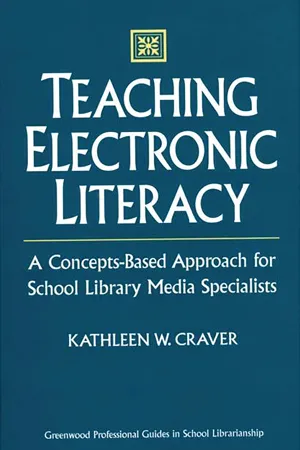
Teaching Electronic Literacy
A Concepts-Based Approach for School Library Media Specialists
- 208 pages
- English
- PDF
- Available on iOS & Android
Teaching Electronic Literacy
A Concepts-Based Approach for School Library Media Specialists
About this book
School library media specialists will find this concepts-based approach to teaching electronic literacy an indispensable basic tool for instructing students and teachers. It provides step-by-step instruction on how to find and evaluate needed information from electronic databases and the Internet, how to formulate successful electronic search strategies and retrieve relevant results, and how to interpret and critically analyze search results. The chapters contain a suggested lesson plan and sample assignments for the school library media specialist to use in teaching electronic literacy skills to students and teachers. Dr. Kathleen W. Craver, a nationally recognized specialist in technology in the library media center, identifies the universal concepts of electronic literacy and provides the library media specialist with the rationales, background, methods, and model assignments to teach students and faculty to become proficient and critical users of electronic information technologies. At the beginning of each chapter, Craver furnishes a rationale for change that school library media specialists can use to justify these essential modifications to their teaching curriculum. Chapters include: The Structure of Electronic Information; The Common Vocabulary and Characteristics of Electronic Resources; Formulating Electronic Search Strategies; The Physical Arrangement of Information; Choosing Appropriate On-Site and Remote Electronic Libraries; Choosing Appropriate Electronic Databases; Internet Search Tools and Techniques; Identifying Electronic Resources; On-Site Electronic Records Access; Using Primary Electronic Resources; and Evaluating Electronic Sources. The Appendix contains a list of principal vendors. A glossary of terms and a bibliography of suggested reading complete the work. This basic teaching guide provides the media specialist with all the tools necessary to help novice users to be successful and avoid the frustration of electronic database searching and retrieval.
Frequently asked questions
- Essential is ideal for learners and professionals who enjoy exploring a wide range of subjects. Access the Essential Library with 800,000+ trusted titles and best-sellers across business, personal growth, and the humanities. Includes unlimited reading time and Standard Read Aloud voice.
- Complete: Perfect for advanced learners and researchers needing full, unrestricted access. Unlock 1.4M+ books across hundreds of subjects, including academic and specialized titles. The Complete Plan also includes advanced features like Premium Read Aloud and Research Assistant.
Please note we cannot support devices running on iOS 13 and Android 7 or earlier. Learn more about using the app.
Information
Table of contents
- Contents
- Acknowledgments
- Introduction: The Rationale for Instructional Change
- 1 The Structure of Electronic Information
- 2 The Common Vocabulary and Characteristics of Electronic Resources
- 3 Formulating Electronic Search Strategies
- 4 The Physical Arrangement of Information
- 5 Choosing Appropriate On-Site and Remote Electronic Libraries
- 6 Choosing Appropriate Electronic Databases
- 7 Internet Search Tools and Techniques
- 8 Identifying Electronic Resources
- 9 On-Site Electronic Records Access
- 10 Using Primary Electronic Resources
- 11 Evaluating Electronic Information Resources
- Appendix: Principal Vendors
- Glossary
- Bibliography
- Index